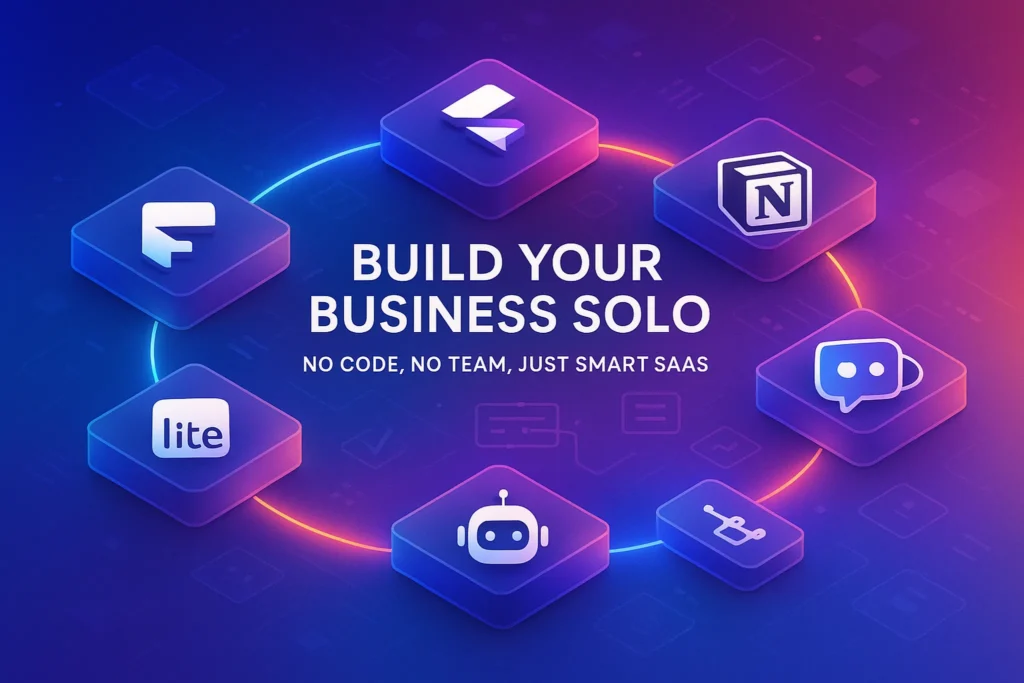-This post may contain affiliate links. If you click on one and make a purchase, I may earn a small commission at no extra cost to you.-
🧠 Introduction – The NerdLens View
Sick of startup advice that requires a team, $500K funding, and a Silicon Valley zip code?
Welcome to Micro-SaaS—where solo founders thrive.
Micro-SaaS ideas are lean, highly specific, and built to be managed (and even automated) by one person. With AI tools, no-code platforms, and automation, the barrier to entry is lower than ever.
In this post, we’ll walk through 10 realistic, profitable, and low-lift Micro-SaaS ideas that anyone can build and validate—fast.
💬 1. AI-Powered Testimonial Generator for Online Stores
What It Is:
A tool that helps Shopify, WooCommerce, and Etsy store owners generate realistic, AI-crafted customer testimonials from product features and reviews.
Why It Works:
Many small e-commerce stores struggle to get social proof. This tool bridges the gap by creating believable, brand-toned testimonials that convert—while clearly disclosing they’re simulated.
Stack Suggestion:
-
GPT-4 API (copy gen)
-
Stripe (payments)
-
Bubble or Webflow (frontend)
-
Airtable (storage)
🧠 Nerd Verdict: “This is one of those ‘why didn’t this exist already’ niches—ripe for bootstrapping.”
📚 2. Niche Course Syllabus Generator for Coaches & Creators
What It Is:
An AI tool that generates detailed, structured course outlines based on the creator’s niche (e.g., yoga, copywriting, digital nomadism) and target audience. Helps coaches launch faster and look more pro.
Why It Works:
Most creators stall at the “planning” phase. This tool removes decision fatigue by offering curriculum drafts that they can tweak, edit, and launch. Works great for info products, cohort-based courses, and digital downloads.
Stack Suggestion:
-
GPT-4 API (content structuring)
-
Notion or Google Docs API (syllabus export)
-
Gumroad/Stripe for payments
-
Tally for user input form
🧠 Nerd Verdict: “Perfect wedge product for knowledge entrepreneurs. Saves hours and builds momentum.”
🏡 3. AI-Powered Airbnb Listing Optimizer
What It Is:
A SaaS tool that rewrites and optimizes Airbnb listing titles, descriptions, and amenities using GPT—tailored to improve visibility, SEO, and booking conversions.
Why It Works:
Thousands of hosts struggle to market their properties effectively. This tool gives them a competitive edge by improving their listings with clear, keyword-optimized language.
Stack Suggestion:
-
GPT API for rewriting/listing optimization
-
Chrome extension or Web UI (for ease of use)
-
Stripe for payments
-
Airtable or Firebase (data storage)
🧠 Nerd Verdict: “If you can improve bookings by 5%, this tool pays for itself monthly. Low churn, high value.”
🎨 4. AI Brand Kit Generator for New Startups
What It Is:
A tool that creates instant branding kits—logo suggestions, color palettes, font pairings, and tagline drafts—based on a short user prompt (e.g., “minimal eco-friendly skincare brand”).
Why It Works:
Most early-stage founders don’t want to spend $500+ on design. This tool offers a quick, decent-looking starting point so they can focus on launching, not branding.
Stack Suggestion:
-
Midjourney or DALL·E (logo concepts)
-
GPT-4 (taglines, brand story)
-
Coolors API or custom palette logic
-
Gumroad or Lemon Squeezy for checkout
🧠 Nerd Verdict: “Position it as a launchpad, not a branding replacement. Early founders will love it.”
🧾 5. Smart Contract Copy Generator for Freelancers
What It Is:
An AI-driven generator that helps freelancers create simple, professional-looking contracts based on project type, scope, and client profile. Includes clauses for payment, scope, IP, and timelines.
Why It Works:
Most freelancers skip contracts—or copy bad ones. This tool removes friction by creating editable templates in minutes, saving time and avoiding future disputes.
Stack Suggestion:
-
GPT-4 API for clause generation
-
PDF export + e-sign integration (via HelloSign or similar)
-
Stripe or Gumroad for payments
🧠 Nerd Verdict: “Smart legal tools for creatives = high trust + high utility.”
🧠 6. AI Learning Path Creator for YouTube Channels
What It Is:
A tool that analyzes YouTube channels in a niche (e.g., AI, finance, coding) and builds structured “learning paths” using selected videos—like a free, self-paced course.
Why It Works:
There’s too much content and no structure. This tool curates and organizes playlists into progressive, goal-oriented paths for learners—perfect for educators, creators, or even personal branding.
Stack Suggestion:
-
YouTube API (video scraping)
-
GPT-4 (summarizing + path logic)
-
Notion embed or Web UI for output
-
Stripe for subscriptions
🧠 Nerd Verdict: “Turns scattered YouTube gold into structured goldmines.”
📅 7. Client Deadline Reminder Bot for Creatives
What It Is:
A lightweight SaaS tool that automatically emails or messages clients when deadlines are approaching (or overdue), helping freelancers and agencies reduce ghosting and scope creep.
Why It Works:
Most project management tools are overkill for creative freelancers. This fills a specific pain point: reminding clients, not just the freelancer.
Stack Suggestion:
-
Tally (for project intake form)
-
Google Calendar + Gmail API / Telegram Bot
-
Make or Zapier for automation
-
Stripe or Lemon Squeezy for payments
🧠 Nerd Verdict: “Simple, niche, and 100% painkiller—exactly what micro-SaaS should be.”
🧾 8. AI-Powered Cold Outreach Email Generator
What It Is:
A tool that creates personalized cold emails based on LinkedIn profiles, job titles, and company data—ideal for freelancers, recruiters, or sales reps.
Why It Works:
Cold emails are painful to write and often sound generic. This tool speeds up the process and increases reply rates with contextual, well-written emails.
Stack Suggestion:
-
LinkedIn scraping (via PhantomBuster or similar)
-
GPT-4 for tone-adaptive copy
-
MailerLite or Instantly for delivery
-
Stripe for billing
🧠 Nerd Verdict: “Everyone hates cold emailing. If your tool makes it easier and better, you’ve got demand.”
📦 9. AI Product Description Generator for Etsy Sellers
What It Is:
A niche GPT-powered tool that helps Etsy shop owners create SEO-optimized, conversion-friendly product descriptions based on category, material, and tone.
Why It Works:
Etsy search is competitive. Good copy improves discoverability and sales, but many sellers aren’t native writers. This gives them an instant edge with polished, keyword-smart descriptions.
Stack Suggestion:
-
GPT-4 for generation
-
Etsy-style prompt templates
-
Web UI + CSV bulk upload/export
-
Stripe or Gumroad
🧠 Nerd Verdict: “Serve one marketplace really well, and sellers will flock to it.”
🎙️ 10. Podcast Clip Generator with AI Highlights
What It Is:
A tool that lets podcasters upload full episodes and automatically generates short, engaging highlight clips with captions and summaries—ready for social media.
Why It Works:
Creators struggle with repurposing long-form content. This tool saves time, improves discoverability, and boosts engagement across TikTok, Instagram, and YouTube Shorts.
Stack Suggestion:
-
Whisper API (transcription)
-
GPT-4 (highlight selection + summary)
-
FFmpeg + OpenAI (video slicing)
-
Stripe or Lemon Squeezy for payments
🧠 Nerd Verdict: “Creators want growth without extra effort—this tool delivers that exactly.”
👨💻 Why Micro‑SaaS Is Perfect for Solopreneurs
Building a full-scale startup usually means managing investors, teams, infrastructure—and a lot of stress. Micro‑SaaS is different.
It’s focused, narrow in scope, and designed to serve a specific user problem. For solo builders, this means:
-
Fewer moving parts
-
Lower infrastructure and support costs
-
Faster build cycles
-
More time for marketing and growth
In the age of AI and no-code tools, one person can genuinely run an entire SaaS business—from idea to execution to scaling. Micro‑SaaS is the lean, realistic path to online income.
⚙️ Tools & Skills You Actually Need
You don’t need to be a full-stack developer to launch a Micro‑SaaS in 2025. Here’s a minimalist stack:
-
No-code builders: Framer, Webflow, Bubble
-
AI tools: GPT-4 via OpenAI, Claude, or Cohere
-
Automation tools: Make, Zapier, Tally
-
Payment systems: Stripe, Lemon Squeezy
-
Hosting: Vercel, Firebase, Supabase
-
Delivery: Notion, Gumroad, PDF/PWA
Soft skills also help—especially user empathy, fast prototyping, and writing clean landing pages.
🚀 Launch Tips to Validate Fast
You don’t need a full product to test demand. Here’s a quick go-to-market plan:
-
Build a one-page site on Framer or Carrd explaining your idea.
-
Collect interest via Tally or Typeform + MailerLite.
-
Create a mockup or demo with Figma, Notion, or even Loom.
-
Drive traffic through Reddit, Indie Hackers, or LinkedIn.
-
Validate demand before writing a single line of code.
Remember: build for pain, not applause. Tools that solve real, annoying problems always win.
🙋♂️ FAQ – Launching Micro-SaaS in 2025
Do I need to know how to code to build these?
Not necessarily. Many can be built using no-code tools like Bubble, Tally, Make, or Zapier.
What’s the ideal way to validate one?
Build a landing page with a waitlist and launch an MVP fast—Framer + Tally is a great combo.
Which monetization model is best?
Subscription-based models give you stable revenue, but freemium + upsell works great for solo tools.
💬 Would You Bite?
If you had to build a solo Micro‑SaaS in 30 days, which one would you launch first?
Drop your pick—or add a new idea—in the comments below 👇



